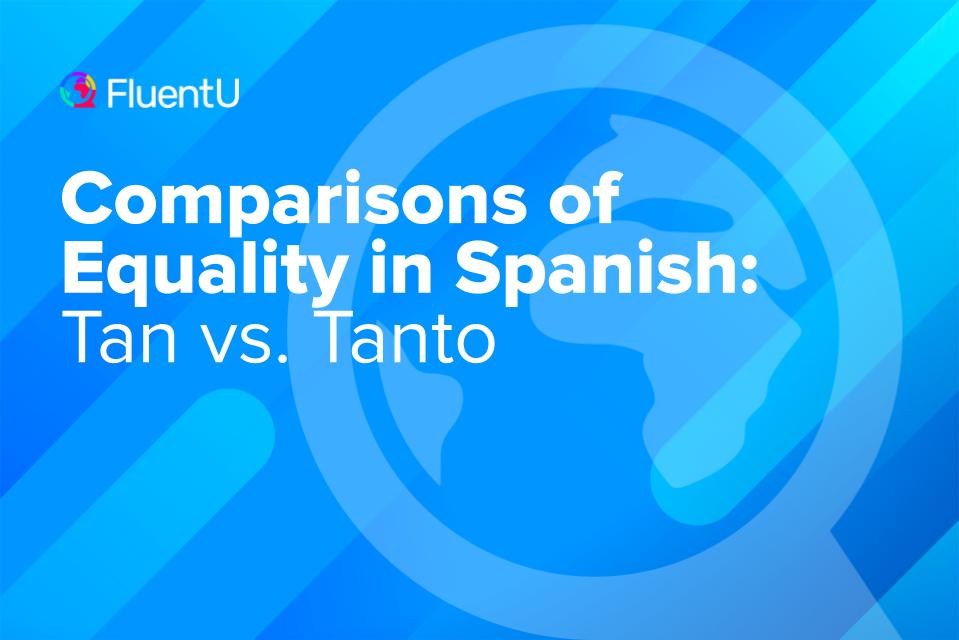Comparisons of Equality in Spanish: Tan vs. Tanto

If you’re like many Spanish learners, you might be puzzled by the distinction between the two small words tan and tanto. Both words are used to make equality comparisons. That is, we use them when we want to say that two things are equal in some respect.
But despite being related, they have different functions and behave differently depending on the context or their position in the sentence.
Download: This blog post is available as a convenient and portable PDF that you can take anywhere. Click here to get a copy. (Download)
The Difference Between Tan and Tanto
In Spanish, tan is used as an adverb to compare adjectives and other adverbs. It’s invariable, meaning it doesn’t change in feminine and plural forms. Tanto mostly functions as an adjective to compare nouns and changes form depending on the gender and number of the noun. It’s also used with como to compare verbs.
Tan means “as” when making comparisons. And as you can see, very often the word como (as, like) will appear when making the comparison.
María es tan guapa como Juana. (María is as pretty as Juana.)
Los vasos son tan caros como los tenedores. (The glasses are as expensive as the forks.)
La niña espera tan pacientemente como sus hermanos. (The girl waits as patiently as her siblings.)
Tanto, on the other hand, means “as much/as many” when used as an adjective. It’s also used to make comparisons.
You can see that, as with other Spanish adjectives, the form changes depending on the gender and quantity of the noun it accompanies. And like tan, it’s often used with como.
Tienes tanto dinero como Andrea. (You have as much money as Andrea.)
Como tanta fruta como mi hermano. (I eat as much fruit as my brother.)
Tenemos tantos coches como Pedro. (We have as many cars as Pedro.)
Quieren tantas piscinas como sus vecinos. (They want as many swimming pools as their neighbors.)
Now that you know today’s two heroes, let’s get down to the nitty-gritty and learn everything about them.
How to Use Tan and Tanto
Tan to Compare Adjectives and Adverbs
Use tan when you need to compare two people, objects or animals and want to say that they share a quality (adjective) or they do something the same way (adverb).
Don’t forget about the word como, which also appears in this type of comparison.
The easiest way to remember all the ingredients here is by using the following formula:
Tan + adjective/adverb + como
Again, remember that the adjective always has to agree in gender and number with the noun it refers to! However, adverbs are always invariable.
All things considered, your Spanish adjective/adverb comparisons should look like this:
El agua es tan barata como la leche. (The water is as cheap as the milk.)
Los niños son tan altos como las niñas. (The boys are as tall as the girls.)
Las tortugas son tan viejas como esta casa. (The turtles are as old as this house.)
La liebre corre tan rápido como el conejo. (The hare runs as fast as the rabbit.)
María escribe tan hermoso como Ana. (María writes as beautifully as Ana.)
If you have a situation where you want to say that two people, objects or animals are not equal in some respect, the only thing you have to do is negate the verb by adding no in front of it:
El zumo no es tan caro como el agua. (The juice is not as expensive as the water.)
Los niños no son tan rápidos como las niñas. (The boys are not as fast as the girls.)
Esta casa no es tan grande como la mía. (This house is not as big as mine.)
El conejo no corre tan elegantemente como la liebre. (The rabbit doesn’t run as elegantly as the hare.)
Ana no escribe tan lento como María. (Ana doesn’t write as slow as María.)
Tanto to Compare Nouns
If you want to compare nouns, you should use tanto and its siblings instead of tan.
As with every Spanish adjective, the sibling you use will depend on the gender and number of the noun you’re trying to compare. Use:
Tanto for masculine, singular (uncountable) nouns
Tanta for feminine, singular (uncountable) nouns
Tantos for masculine, plural nouns
Tantas for feminine, plural nouns
Remember that this family of adjectives has a close friendship with the word como as well:
Tanto/a/os/as + noun + como
Let’s take a look at some examples:
Bebo tanto té como tú. (I drink as much tea as you.)
Tenemos tanta suerte como ellos. (We have as much luck as them.)
Pepe lee tantos libros como Miranda. (Pepe reads as many books as Miranda.)
Mamá necesita tantas pistas como tú. (Mom needs as many hints as you.)
Just like when we use tan, we can negate the sentences by just adding no in front of the verb:
Tú no bebes tanto café como él. (You don’t drink as much coffee as him.)
Ellos no tienen tanta suerte como yo. (They don’t have as much luck as me.)
Miranda no lee tantos libros como Pedro. (Miranda doesn’t read as many books as Pedro.)
Tú no necesitas tantas pistas como Anna. (You don’t need as many hints as Anna.)
Tanto Como to Compare Verbs
Yes, you can compare actions, too! Or rather, you can say that two people or animals do something the same way, or with the same intensity, or in equal amounts—just to name a couple of situations.
For this use, you’ll always use the words tanto como after the verb.
Watch out, though! Tanto here isn’t an adjective, so it’s invariable (meaning always the same, no matter the context).
The formula this time is:
Verb + tanto como + verb/noun
Have a look at some examples:
María come tanto como Pedro. (María eats as much as Pedro.)
Juan no estudia tanto como César. (Juan doesn’t study as much as César.)
Yo no juego tanto como debería. (I don’t play as much as I should.)
Ella no cocina tanto como limpia. (She doesn’t cook as much as she cleans.)
Special Cases for Using Tan and Tanto
There are a couple of special situations where tan and tanto behave differently or are accompanied by words other than como.
Here are the most important special cases:
Tan + adjective/adverb + que
Use this formula when you want to make a deduction or affirmation about someone or something:
Juan es tan inteligente que se aburre en clase. (Juan is so intelligent that he gets bored in class.)
El libro es tan caro que nadie lo quiere comprar. (The book is so expensive that no one wants to buy it.)
Tanto/a/os/as + noun + que
Use this construction when you want to say “so much/many” of something that something happens as a result:
Comió tanto helado que se puso enfermo. (He ate so much ice cream he got sick.)
Había tanta gente que tuvieron que cerrar el puente. (There were so many people they had to close the bridge.)
Tanto + noun + como + noun
Use this formula when you want to say that both A and B do something:
Tanto Pedro como Juan leen mucho. (Both Pedro and Juan read a lot.)
Tanto el vaso como el tenedor costaron 20 dólares. (Both the glass and the fork cost $20.)
Tanto Gracita como Antonio son muy felices. (Both Gracita and Antonio are very happy.)
As you can see, tan and tanto are small but powerful words that can help you easily build equality comparisons in Spanish.
If you need more practice seeing tan and tanto in different contexts, you can use a program like FluentU.
FluentU takes authentic videos—like music videos, movie trailers, news and inspiring talks—and turns them into personalized language learning lessons.
You can try FluentU for free for 2 weeks. Check out the website or download the iOS app or Android app.
P.S. If you decide to sign up now, you can take advantage of our current sale!

You now have all the info you need to make equality comparisons, so grab a pencil and a piece of paper and start practicing what you’ve just learned!
Download: This blog post is available as a convenient and portable PDF that you can take anywhere. Click here to get a copy. (Download)
And One More Thing…
If you've made it this far that means you probably enjoy learning Spanish with engaging material and will then love FluentU.
Other sites use scripted content. FluentU uses a natural approach that helps you ease into the Spanish language and culture over time. You’ll learn Spanish as it’s actually spoken by real people.
FluentU has a wide variety of videos, as you can see here:

FluentU brings native videos within reach with interactive transcripts. You can tap on any word to look it up instantly. Every definition has examples that have been written to help you understand how the word is used. If you see an interesting word you don’t know, you can add it to a vocab list.

Review a complete interactive transcript under the Dialogue tab, and find words and phrases listed under Vocab.

Learn all the vocabulary in any video with FluentU’s robust learning engine. Swipe left or right to see more examples of the word you’re on.

The best part is that FluentU keeps track of the vocabulary that you’re learning, and gives you extra practice with difficult words. It'll even remind you when it’s time to review what you’ve learned. Every learner has a truly personalized experience, even if they’re learning with the same video.
Start using the FluentU website on your computer or tablet or, better yet, download the FluentU app from the iTunes or Google Play store. Click here to take advantage of our current sale! (Expires at the end of this month.)







